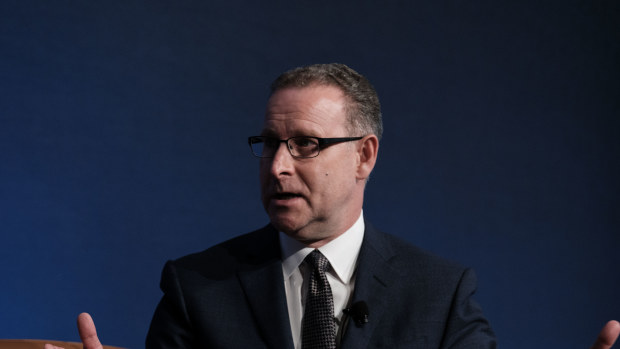Unions’ 5pc wage claim will keep interest rates high: business

Unions’ push for a 5 per cent increase in minimum rates for 2.9 million workers will ensure interest rates remain higher for longer and restrict hiring, businesses warned.
Australian Chamber of Commerce and Industry chief executive Andrew McKellar on Tuesday attacked the ACTU for claiming its minimum wage claim would not drive up inflation at the same time as it suggested firms had the flexibility to lift prices to absorb the extra cost.

Australian Chamber of Commerce and Industry chief executive Andrew McKellar said 5 per cent pay rises would cost jobs for smaller businesses. Oscar Colman
The Australian Council of Trade Unions wants 5 per cent to ensure workers make up real wage cuts over the last few years, despite last year’s 5.75 per cent increase in award rates marking the highest in more than 40 years.
“Five per cent – I mean that is basically an open letter to the governor of the Reserve Bank saying that they would be happy for interest rates to remain higher for longer,” Mr McKellar told the ABC.
Responding to ACTU secretary Sally McManus’ comments that “when inflation goes up businesses are able to adjust their prices to protect their margins”, Mr McKellar said such price rises were “to absorb the cost of higher wage increases”.
“That is basically, again, inviting or suggesting that inflation will continue to remain higher for longer,” he said.
ACCI will argue for an increase of no more than 2 per cent this year given inflation is forecast to fall to 3 per cent, productivity is going backwards and past decisions “overcompensated” for inflation.
However, the ACTU has said that 2023’s record-high increase oversaw a rapid fall in inflation over the year and proved a 5 per cent wage increase would not have negative effects.
Commonwealth Bank chief economist Gareth Aird disagreed and said last year’s increase contributed to a 1.2 per cent increase in inflation in the third quarter, which led to rate rises later that year.
‘Gone backwards’
“The Reserve Bank was on hold for a while but ended up raising rates in November because Q3 came in stronger than expected, and core inflation accelerated,” he said.
Mr Aird said the union’s 5 per cent claim “is not consistent with inflation, it will have an inflationary impact”.
However, this year businesses would be limited in how much they could lift prices to absorb the extra wage costs given that GDP growth was weak.
“It’s gone backwards per person so it’s harder for businesses to raise prices for goods and services, particularly those in discretionary spending space,” he said.
CBA is expecting the Fair Work Commission will deliver an increase to the minimum wage of between 4 and 4.25 per cent.
Westpac senior economist Pat Bustamante expected the wage decision to have a “three in front of it” given inflation was declining. He argued soft wage rises in individual agreements would offset its effect on overall wage growth.
The bank is forecasting wages to grow 3.25 per cent in the year to September and underlying inflation to drop to 3.2 per cent over the same period, although with a pick-up of 0.9 per cent in the quarter.
Mr Bustamante said last year’s minimum wage rise was a factor that contributed to the stronger-than-expected rise in inflation in the September quarter but did not appear to have spillover effects for overall wage growth.
“We didn’t see a broader increase in the underlying momentum of wages growth – it was concentrated in that wage-setting mechanism,” he said.
Weaker employment
Mr McKellar said while supply chain issues were starting to ease, small and medium-sized businesses were still struggling with wage costs that had increased at about 4 per cent on average.
“If we were to push that up higher, then there’s no doubt that that would even more rapidly impact hiring decisions, and we are starting to see that,” he said.
Last week’s strong jobs figures, where unemployment unexpectedly dropped to 3.7 per cent in February and employment rose by 116,500 people, was “an aberration”.
“We think that’s distorted,” he said. “Our concern is that we will see weaker employment in the months ahead.”
The “critical” factor to justify higher wage rises had to be productivity.
“I can’t remember the last time that I heard an Australian union leader using the word productivity,” Mr McKellar said.
Subscribe to gift this article
Gift 5 articles to anyone you choose each month when you subscribe.
Subscribe nowAlready a subscriber?
Introducing your Newsfeed
Follow the topics, people and companies that matter to you.
Find out moreRead More
Latest In Workplace
Fetching latest articles